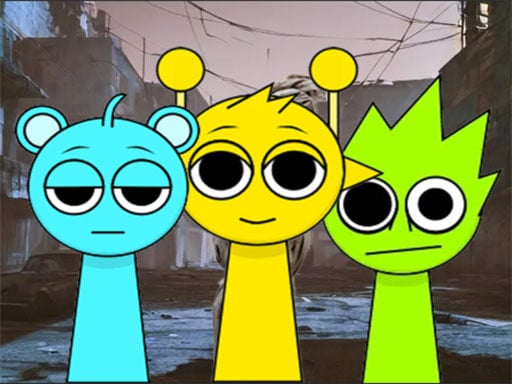Thung Thung Sahur Night Escape
Played 5 times.
How to Play
Game Description
Thung Thung Sahur Night Escape: Survive the Haunted Village
Can You Rescue the Brainrot Creatures Before the Terror Finds You?
Moonlight filters through decaying rooftops as you crouch behind crumbling walls, heart pounding against your ribs. This is Thung Thung Sahur Night Escape – where every shadow breathes and every whisper could be your last. As a horror game enthusiast, I've crept through countless virtual nightmares, but few have captured primal dread like this first-person stealth experience. Set in an abandoned village frozen in time, this isn't just about jump scares; it's a psychological chess match against an entity that wants to be found.
The Village That Whispers
Developers have crafted something special with the environment. You'll navigate through overgrown courtyards where nature has reclaimed cobblestone paths, past houses with doors that swing on rusted hinges like broken teeth. The abandoned village setting isn't just backdrop – it's a character. Atmospheric details pull you deeper: distant wind chimes made of bone, children's drawings fluttering on frayed strings, and the persistent smell of damp earth and decay. What truly elevates the immersion is the dynamic sound design. A snapped twig echoes differently in fog than in rain, forcing you to master audio cues for survival.
Pro Tip: Listen for the Brainrot creatures' faint whimpering – it's directional. Crouch near walls to amplify sounds through the crumbling architecture.
Your Impossible Mission
At its core, this horror stealth adventure presents a seemingly straightforward objective: locate and free twelve imprisoned Brainrot creatures before dawn. These pitiful entities emit soft bioluminescent pulses, creating haunting beacons in the darkness. But here's where the genius tension builds – every rescue alerts Tung Tung Sahur to your presence. Early in my playthrough, I learned the hard way that saving three creatures consecutively causes the entity to manifest nearby, its jerky movements visible through walls. The game brilliantly balances risk/reward: rescue quickly and face immediate danger, or prolong the terror with methodical planning.
The Anatomy of Terror: Tung Tung Sahur
Let's discuss the magnificent horror of your pursuer. Unlike typical monsters, Tung Tung Sahur operates on disturbing pseudo-logic. It doesn't just chase; it calculates. During my midnight gameplay sessions, I observed terrifying patterns: it remembers your frequent routes, sets traps near previously freed cages, and mimics the Brainrots' cries. Most chilling is its appearance – imagine a humanoid figure composed of stretched shadows and cracked porcelain, moving with unnatural joint articulation. The true horror emerges when it pauses... and you realize it's not pathfinding. It's listening.
Mastering Stealth Mechanics
Survival demands mastery of three core stealth gameplay systems:
1. Light Manipulation: Your greatest ally and betrayer. While moonlight reveals safe paths, carrying a rescued Brainrot makes you glow brighter. I often left creatures near exits while scouting ahead – a strategy with emotional consequences when their whimpers grow desperate.
2. Environmental Interaction: Tossing stones to create diversions seems standard until you discover Tung Tung Sahur investigates sounds in evolving patterns. Later encounters require setting chain reactions: toppling barrels to mask your footsteps with noise.
3. Breath Control: Holding your breath via mouse trigger silences panting during sprints but blurs vision after 15 seconds – creating brutal risk/reward moments when hiding in closets as the entity searches nearby.
Why Horror Fans Can't Look Away
Beyond the terrifying stealth sequences, what makes this game exceptional is its emotional texture. Notes scattered throughout the village reveal the Brainrots were once villagers, transformed by Sahur's curse. Finding a doll beside a child's cage adds heartbreaking weight to rescues. The genius environmental storytelling forces you to care, transforming routine objectives into moral imperatives. During my final rescue attempt, I hesitated at a critical moment – could I sacrifice one creature to save two others? The game offers no easy answers, only consequences.
Advanced Strategy: Sahur manifests faster near water. Use the central well as bait by triggering noises there, then flank through the bakery's broken ovens.
Optimizing Your Night Escape
Based on multiple playthroughs, here's how to survive longer:
• Audio Setup: Play with headphones. Sahur's proximity is telegraphed through subtle audio layering – distant rattling shifts to clear dragging sounds when danger is near.
• Route Planning: Start with perimeter rescues. The church and blacksmith locations provide multiple escape routes when Sahur appears.
• Distraction Timing: Throw objects just BEFORE rescuing to mask cage-opening sounds. Wait 8 seconds after Sahur's manifestation before moving – early movement triggers aggression.
• The Shard Technique: Collect mirror shards to create temporary light barriers. These won't stop Sahur but force pathing detours, buying precious seconds.
Thung Thung Sahur Night Escape redefines horror-stealth fusion by marrying psychological tension with innovative mechanics. Unlike jump-scare reliant titles, this game cultivates lingering dread through masterful environmental storytelling and an antagonist that evolves with your strategies. The abandoned village feels authentically haunted, while the Brainrot rescue missions create emotional stakes rare in the genre. For those seeking a horror experience that stays with you long after the screen goes dark – where every rustle in the night might be Sahur creeping into your reality – this terrifying masterpiece belongs in your library. Just remember: it's not about escaping the village. It's about escaping with your sanity intact.


















































